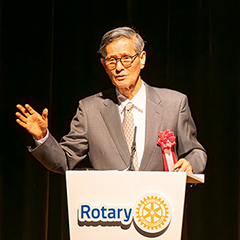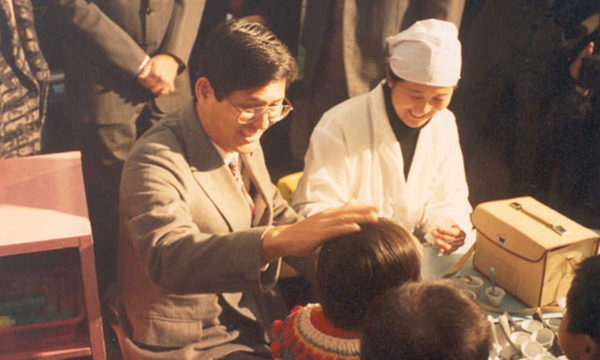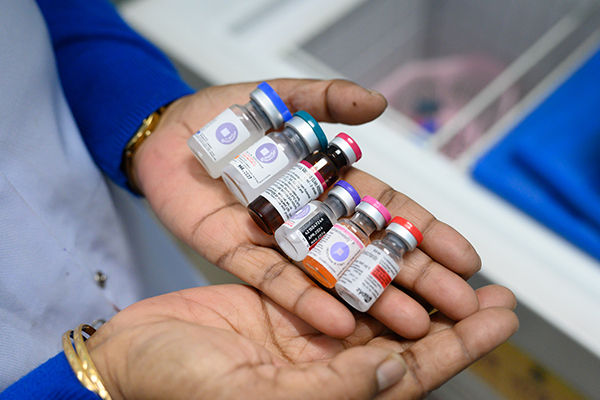Editor’s Note: This year marks the 25th anniversary of the World Health Organization’s certification of the Western Pacific Region as polio-free. To commemorate this anniversary, we invited Dr. Shigeru Omi, who led the WHO’s polio eradication efforts in the region from start to finish, to reflect on the story behind that victory.

By Dr. Shigeru Omi —
I still remember the book that changed everything. It was a quiet afternoon in Shibuya, sometime in the early 1970s. I was a restless university student, unsure of my path, wandering the aisles of Tokyo’s largest bookstore. A slim volume caught my eye – a personal account written by a psychiatrist. As soon as I opened it, the idea of medicine, the calling of a doctor, and the dignity it held hit me all at once. That night, I made up my mind. I would become a doctor.
Years later, after a decade of practice in rural clinics, hospitals, and sleepless shifts, I found myself searching for something more – work that was not only rewarding, but broadly impactful. I applied for a position at the World Health Organization (WHO). At the time, two posts were available: one, a high-ranking assistant to the regional director; the other, a lower-paid technical officer for polio eradication. I chose the latter. That’s how I began my journey to help lead the charge against polio across the vast and complex Western Pacific region.
The Polio Frontline of 1990
When I started in 1990, most people thought the goal was impossible. The virus was still endemic in large parts of Asia. There was no money. No roadmap. Just a ticking clock and a resolution passed by WHO: to eradicate polio by the year 2000. It was, in a word, chaos.
The first thing I noticed was the absence of basic surveillance systems. Cases of acute flaccid paralysis – a category of disease polio belongs to – went undetected, unreported, and not tested to be diagnosed. Official records showed only 6,000 cases per year. But we all knew that number was wrong. The virus wasn’t hiding. We were simply blind to it.
Of course, there were more. In Cambodia and Vietnam, families lived on boats, drifting along rivers – unreachable, undocumented, and highly vulnerable to disease. In places like Mindanao in the Philippines, conflict made access nearly impossible. In China, children born outside the “one child” policy were often not registered at all. No documents meant no health services – and no vaccines. These unregistered children were the ones polio found first.
And one of the greatest challenges was funding. Even purchasing enough vaccine required millions of dollars – not to mention the operational cost, resources needed to build infrastructure, train health workers, and reach remote communities. I organized a major technical meeting in Tokyo in 1991, bringing together every expert in the region working on polio, hoping that some organizations, or some countries would decide to give us money. We followed up with another meeting in the Philippines. But no one offered money. Not a single pledge.
The wise men from Rotary
It was October 1992. I had organized yet another technical meeting – this time in Beijing. And this time, something different happened.
Just hours before the meeting, three men visited me – Rotarians from Japan, India, and the United States. They weren’t strangers. They had attended previous meetings and understood the technical details. They came with an offer: “If you agree to lower the target age for vaccination from under five to under four,” they said, “we will donate US$1.5 million immediately.”
Their reasoning was practical. WHO’s global policy was to vaccinate all children under five. But only in China, nearly all polio cases occurred in children under four. Reducing the target age would make the campaign more focused and efficient. They wanted their contribution to have the greatest possible impact.
I was thrilled. Electrified. The logic was clear, and the funds could kick-start what had felt like a stalled campaign. But WHO headquarters in Geneva pushed back. They didn’t want to change policy to match a donor’s condition. I understood the concern, and yet, I also knew what US$1.5 million could do. It was a catalyst.

So, I took a risk. I asked a senior Geneva colleague – the most vocal opponent – to quietly step out of the room. During his absence, the rest of us came to a consensus: we would accept Rotary’s condition and proceed.
That single decision changed everything. The US$1.5 million was our first real pool of funding. Rotary didn’t just write a check. They showed up. And they stayed. They became true partners; a global network of committed individuals who would go on to advocate, fundraise, vaccinate, and build trust in places where even governments struggled to reach.
The breakthrough
Momentum came slowly and then all at once. Rotary’s initial funding unlocked attention and credibility. Other donors followed. Working with governments and visiting local communities, we built surveillance systems where none existed. We mobilized lab networks to test all cases of paralysis and accurately diagnose polio.
In Vietnam and Cambodia, we launched “vaccine boats” – floating checkpoints on the Mekong River, ensuring every child was vaccinated before passing through. In conflict-affected Mindanao, we secured a temporary ceasefire to carry out immunization campaigns.
China posed a different challenge: undocumented children born outside the one-child policy. I met directly with the Minister of Health. I didn’t debate policy. I simply shared the data. Weeks later, at a national meeting, the Minister publicly announced that “all children” would be vaccinated. That’s when I knew we had a real shot. And after three years, China reached polio-free status.
The last mile is the hardest
In 2000, we celebrated the certification of the whole WHO Western Pacific Region as polio-free. It was a moment we’ve earned in collaboration through tireless work. It was proof that eradication wasn’t just a dream. It could be done.
But polio still exists in Pakistan, Afghanistan, and in places where health systems are fragile and conflict is constant. And as we saw recently in Gaza, the disruption can reopen the door. And it only takes one spark to undo decades of progress.
Rotary knows this. You’ve seen how far we’ve come. But I must say this: the last mile is always the hardest, as hard as the first million. It always has been, for every communicable disease we’ve fought. That is the nature of eradication. It demands that we renew and reconfirm our commitment, again and again.
Rotary’s role has never been more vital. You are not just funders. You are advocates, partners, and frontline agents of change. You’ve helped make history once. Now, we must finish the story together.
Dr. Shigeru Omi is a global health expert and former Regional Director of the World Health Organization Western Pacific Region (1999–2009). He joined WHO in 1990 and played a leading role in launching and completing the region’s polio eradication effort, which led to its certification as polio-free in 2000. He also led the response to the 2003 SARS outbreak and later served as chair of the Japanese government’s COVID-19 advisory panel. Dr. Omi currently serves as chair of the Japan Anti-Tuberculosis Association and Rotary Polio Eradication Ambassador.

https://blog.rotary.org/2025/04/29/from-hope-to-history-how-we-defeated-polio-in-the-western-pacific/

